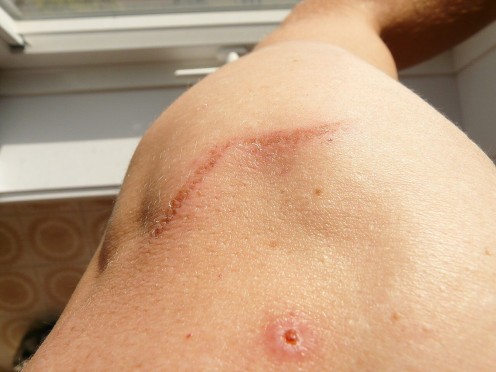Scar tissue forms in injured areas of our bodies and replaces cells that have been destroyed. It appears either inside the body or on its surface and is a normal part of the body's healing process whenever we have a significant injury. Scar tissue acts as a barrier and protects the place that was injured, but it unfortunately lacks the functionality of the original tissue and has low elasticity. On the surface of the body it may be a cosmetic problem or even be disfiguring.
Scar tissue on our skin looks different from the surrounding area and is usually referred to as a “scar". Some people develop hypertrophic scars on their skin. These are larger than normal and have a lumpy appearance. Keloid scars are raised and spread beyond the wound. Atrophic scars are sunken and form depressions in the skin. Inside the body, scar tissue in the form of adhesions or fibrosis may cause problems
Scar tissue is made of fibrous connective tissue. Connective tissue supports and connects body structures and holds them in place. Fibrous connective tissue contains fibres made of a protein called collagen. It also contains cells called fibroblasts, which make the collagen, as well as water and carbohydrates.
Fibrous connective tissue is sometimes known as dense connective tissue because the collagen fibres are densely packed and there are comparatively few cells present. It's a normal component of the body and is present in uninjured areas. Researchers have discovered that the connective tissue in scars has a slightly different structure from normal fibrous connective tissue.
Causes -- Scars may be caused by wounds such as burns, surgical incisions, physical injury, chemical injury, infections, diseases, inflammation and acne. Not all wounds cause scars. There must be significant damage to the body before scar formation is triggered. Some people tend to form scars more easily than others, however.
Scars on the skin are red when they are first made due to an increased blood flow as the wound heals. Over time, the blood supply decreases and the scar becomes paler. Scars may take many months or even years to reach their final form.
Skin scars are thicker than their surroundings. The scar lacks hair, sweat glands, and melanin (the chemical which protects the skin from ultraviolet radiation).
Abnormal skin scars
Hypertrophic Scars: In a hypertrophic scar too much collagen is made. The scar forms a raised area or lump above the wounded area of the skin. The lump is often pink in its early stages and may be itchy.
Keloid Scars: Keloid scars grow beyond the wound, forming a reddish tumour. This tumour is benign (not cancerous) and consists mainly of collagen. Keloid scars may form as a response to injury, but in some people they form spontaneously, with no known cause. They may be itchy and create a burning sensation.
 Atrophic Scars: Atrophic scars look like pits in the skin and may be formed during skin problems such as acne and chicken pox. In this case, not enough connective tissue is formed to fill in the wound.
Atrophic Scars: Atrophic scars look like pits in the skin and may be formed during skin problems such as acne and chicken pox. In this case, not enough connective tissue is formed to fill in the wound.HOMOEOPATHIC REMEDIES
Homoeopathic remedies are best for dissolving scars without any side effects. Some of the important remedies are given below-
CAUSTICUM 200-Causticum is the top Homeopathic medicine for scar formation following burns.It is suitable for deep scars. It works well in treatment of both scar formation soon after burns and when old burn scars resurface and re-freshen, leading to Keloid formation
CALCAREA FLUOR. 6X- Calcarea fluor. is best for deep scars. Injuries become sore again. Calcarea fluor. is good for birth marks, scar marks and hard skin.
GRAPHITES 30-Graphites is another remedy , and it is of great help for the early stage of scar formation. Graphites acts very effectively in the very beginning of formation to absorb the scar tissue and dissolve the scar.Somtimes from the scar oozes out a thin, sticky fluid.
SILICEA 200-Silicea is very effective for scar tissues especially forming after after drying up of pimples , blotches or ulcers. It is also good for scar formation after vaccination. Sometimes there is fistulous furrowingunder the process of suppuration. Also constitutional symptoms like , excessive offensive sweat on feet and sensitivity towards cold air may be present.The patient is chilly.
CROCUS SATIVA 30 and LACHESIS 200- Both Crocus and Lachesis are best for old scars of wounds open again and again with a tendency to suppurate.
LYSSIN 200-Lyssin is effective for dissolving scars left by the bite of a dog.
HYPERICUM PER. 12X- Hypericum is effective when nerves are affected. There is slight paralysis due to entanglement of nerves in the scar. Hypericum is best for removing effects of pain and bruises or injury to an old scar.
STAPHYSAGRIA 30-Silicea is best for burning pain in the scar of an abdomen after the operation.
FLUORIC ACID 30-- Fluoric Acid is the best for scars that itch.The old scars become red around edges and itch. The itching disappears following the use of Fluoric Acid and the scars also begins to disappear . The itching may get worse by heat
VARIOLINUM 200, and THUJA OCCIDENTALIS 1000—These two remedies are used for the removal of ugly scars left after cure of small pox and chicken pox.
VARIOLINUM 200 n SARRACENIA IX—These remedies are best for removing scars left by small pox , or chicken pox on the face.
No comments:
Post a Comment